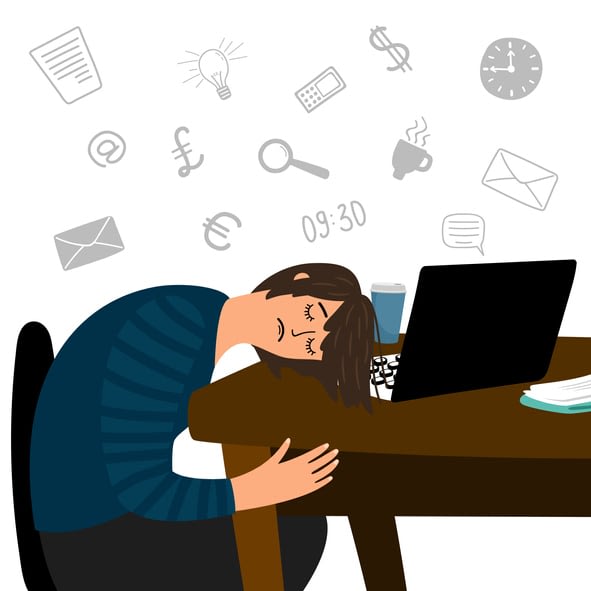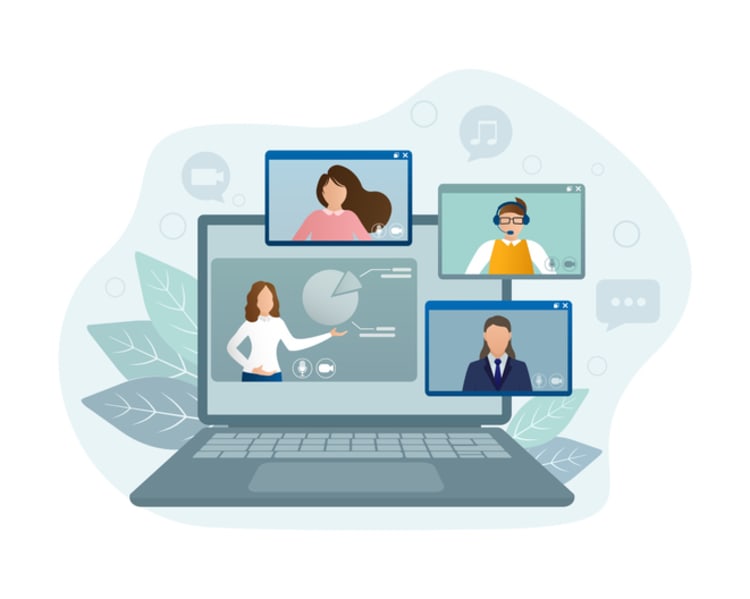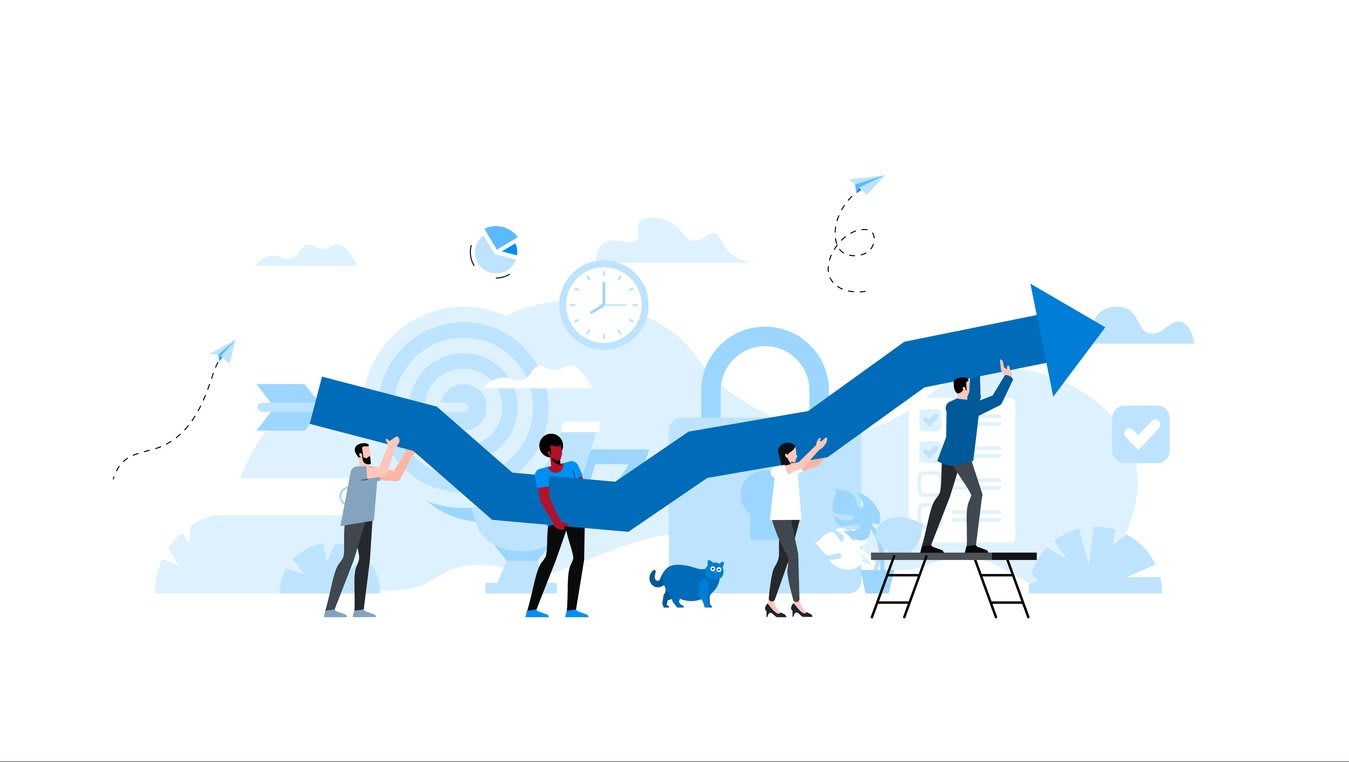Are you tired of unproductive meetings that drain your energy and time? You’re not alone. It’s time to revolutionize the way we conduct meetings and make them an efficient and enjoyable part of our work lives. In this blog post, we’ll dive into the true cost of meetings waste time, identify common meeting time wasters, and provide actionable strategies to enhance virtual meeting efficiency, implement meeting-free days, and increase participant engagement.
Short Summary
- Reduce meeting waste time in 2023 with effective strategies such as introducing meeting-free days, utilizing asynchronous communication and creating a collaborative environment.
- Identify common time wasters like ineffective agendas, lack of clear objectives and disruptions/distractions to ensure productive meetings.
- Maximize virtual efficiency by preparing for technical challenges, encouraging remote participation and adapting traditional formats. Also track action items & progress for successful outcomes!
The True Cost of Unproductive Meetings

Unproductive meetings, often referred to as bad meetings, can have a significant impact, resulting in lost time and money, decreased employee engagement and productivity, and a negative impact on morale. The Harvard Business Review estimates that employees spend nearly a third of their meeting time in unproductive meetings. In an increasingly digital world, virtual meetings are also susceptible to these issues, making it essential to learn and apply strategies for making meetings more effective.
Not only do bad meetings lead to wasted time and resources, but they also reduce employee engagement and performance. Bad meetings happen, and when they do, they can ultimately result in lost productivity and delayed projects, making it crucial for the meeting host to ensure the meeting is well-organized and productive.
In the following sections, we’ll explore the impact of unproductive meetings on time management, financial implications, and employee satisfaction.
Impact on time management
Did you know that?
- 47% of employees feel that meetings, including video meetings, are the most unproductive use of their work time?
- 91% of employees admit to daydreaming during a meeting?
- 39% of employees have experienced the temptation to doze off during a meeting, even when in a conference room?
These statistics show that unproductive meetings affect time management by taking away precious time that could be used for productive work.
Off-topic conversations and a lack of a clear meeting agenda can easily take up a lot of meeting time, distracting the group from the main goal. Status update meetings, for example, can be particularly impacted by not having a meeting agenda or proper meeting notes, resulting in a huge drain on time.
To combat this issue, it’s vital to set clear objectives and create an agenda to ensure that the meeting stays on track, time is used efficiently, and everyone knows what is expected of them.
Financial implications
Unproductive meetings don’t just waste valuable time, they also come with a hefty financial cost. A staggering $37 billion is lost every year due to wasted time in meetings, making it essential to evaluate each meeting invite carefully. The financial toll of inefficient meetings in the United States is staggering – amounting to $399 billion annually. These unproductive meetings are a drain on resources that can be utilized elsewhere. With these numbers in mind, it’s clear that optimizing meeting efficiency is crucial for boosting productivity and saving valuable resources.
So how can organizations maximize their financial efficiency by reducing wasted time in most meetings? Optimizing meeting length, boosting productivity, cutting down on unnecessary meetings, and introducing better planning practices can all help to achieve this goal and encourage participation, especially when it comes to an hour-long meeting.
In the next sections, we’ll provide strategies for identifying common meeting time wasters and maximizing virtual meeting efficiency.
Employee satisfaction
The impact of unproductive meetings doesn’t stop at time and money; it also affects employee satisfaction and engagement. Bad meetings can have a detrimental effect on morale and job satisfaction, making it essential for meeting leaders to ensure the meeting is well-organized and productive. Additionally, implementing strategies such as:
- Introducing meeting-free days
- Utilizing asynchronous communication
- Reassessing meeting frequency and necessity
- Assigning roles and responsibilities
- Creating a collaborative environment
Ensuring that everyone is on the same page can boost employee satisfaction, both in and out of the conference room.
By addressing the impact of unproductive meetings on employee satisfaction, companies can create a more positive work environment, promote increased engagement, and ultimately achieve better results. In the following sections, we’ll delve into:
- Identifying common meeting time wasters
- Maximizing virtual meeting efficiency
- Implementing meeting-free days and other strategies to enhance employee satisfaction.
Identifying Common Meeting Time Wasters

It’s crucial to pinpoint the common factors that lead to meetings taking up more time than necessary. Some of these factors include having an ineffective agenda, not setting clear objectives, and allowing disruptions and distractions during meetings, including video meetings. By addressing these issues, meeting leaders can ensure that the meeting stays on track and that everyone knows what is expected of them to make the most of the meeting.
In this section, we’ll explore the root causes of meeting time waste and provide solutions to overcome them. From crafting effective agendas to maintaining focus during meetings, we’ll share strategies to help you get the most out of your meetings and ensure that time is spent productively.
Ineffective agendas
Crafting a meeting agenda is essential because it guarantees that everyone is aware of the purpose of the meeting prior to getting together. A successful meeting agenda should be focused, well-structured, and realistic to ensure everything can be achieved within the allotted time. But how can we ensure that we don’t spend too much time on any one topic? Adding time blocks to the agenda will help us stay focused and make sure we don’t spend too much time on any one topic.
To create an effective agenda, make sure it includes what topics need to be discussed, why each person’s presence is necessary, and what decisions, information, or solutions need to be determined. With a well-crafted agenda, everyone can come prepared to discuss the most relevant topics, making the meeting more efficient and productive.
Lack of clear objectives
Setting clear objectives is key to ensuring a program or project is reaching its goals and maintaining focus during meetings. Not setting clear objectives in meetings can cause:
- Confusion
- Use up valuable time
- Lead to ineffective decisions
- Lack of direction and clarity makes it challenging for employees to know how to direct their efforts.
To ensure that your objectives are clear, set measurable goals, break down tasks into smaller, achievable steps, and set deadlines. By planning ahead and acting as a meeting organizer, you can help increase focus and ensure that attendees can make an informed decision about whether to accept the meeting invite.
Disruptions and distractions
Disruptions and distractions in meetings can have several negative effects, including:
- Reduced productivity
- Increased errors
- Stress-related ailments
- Diminished quality of work
- Hampered worker concentration and performance
With nearly one-third of employees spending their meeting time in unproductive meetings, it’s crucial to address these issues and minimize distractions during meetings.
One way to make the most of technology in meetings is to ensure everyone has the right tools and offer training if needed. By addressing common disruptions and distractions, such as technology issues or off-topic conversations, you can help keep meetings on track and focused on achieving the desired outcomes.
A great platform to have productive and collaborative meetings is Kumospace. This platform is an innovative platform designed to enhance productivity in virtual meetings. It offers a unique spatial video chat feature that simulates the experience of being in a real room, fostering presence and engagement. Users can move around, have side conversations, control their audio environment, and customize their virtual space. With integrated tools like screen sharing and chat functions, it provides a comprehensive solution for interactive and focused meetings, making it a preferred choice for teams everywhere.
Maximizing Virtual Meeting Efficiency

With the rise of remote work and virtual meetings, it’s more important than ever to ensure that meetings are efficient and productive. In this section, we’ll provide tips and best practices for conducting effective virtual meetings that save time and resources, without compromising on collaboration and communication.
From preparing for technical challenges to encouraging remote participation, we’ll share strategies to help you make the most of virtual meetings and ensure that your team stays connected and engaged, even when they’re not in the same conference room.
Preparing for technical challenges
Technical challenges are an inevitable part of virtual meetings, but with proper preparation, you can prevent and address issues before they derail your meeting. Here are some steps you can take to ensure successful virtual meetings:
- Test equipment beforehand to ensure everything is working properly.
- Make sure everyone attending the meeting has the necessary software and hardware.
- Have a backup plan in case of technical issues, such as a secondary platform or alternative communication method.
By following these steps, you can minimize the impact of technical challenges and have more productive virtual meetings.
In addition to these preparations, it’s important to troubleshoot any issues that may arise during the meeting, restart devices if necessary, and have a backup device or internet connection at the ready. By anticipating and addressing technical difficulties, you can minimize disruptions and keep your virtual meetings running smoothly.
Encouraging remote participation
Engaging remote team members and fostering a collaborative virtual environment can be challenging, but it’s crucial for maximizing the efficiency of your virtual meetings. Here are some strategies to foster remote participation in meetings:
- Building and distributing an agenda
- Hosting recurring meetings
- Beginning with icebreakers or exercises
- Asking other employees to present
- Inviting guest speakers
By implementing these strategies, you can create a more engaging and productive virtual meeting environment.
Setting expectations for participation, calling people by name, assigning roles, and appreciating contributions can also help create a collaborative virtual environment. By implementing these strategies, you can ensure that remote team members feel included and engaged, leading to more productive and effective virtual meetings.
Adapting traditional meeting formats
As the world continues to embrace remote work, it’s important to adapt traditional in-person meeting formats to better suit virtual settings. By using different icebreakers and warm-ups tailored to the group, using multiple formats to present information, and always having a clear purpose for the meeting, you can make your traditional meeting formats more engaging and effective in a virtual setting.
Additionally, creating an agenda, assigning meeting roles, and prioritizing teamwork over-reporting can make team meetings more productive and successful in a virtual environment. By adapting your traditional meeting formats to suit the needs of remote teams, you can ensure that your meetings remain efficient and productive, no matter where your team members are located.
Implementing Meeting-Free Days and Other Strategies

While meetings are an essential part of collaboration and communication, it’s important to recognize that they’re not the only way to keep your team connected and informed. In this section, we’ll propose alternative approaches to managing team communication and collaboration without relying solely on meetings.
From implementing meeting-free days to utilizing asynchronous communication and reevaluating meeting frequency and necessity, these strategies can help you strike a balance between meetings and focused work, ultimately increasing productivity and improving team satisfaction.
Establishing meeting-free days
Implementing a designated day without meetings can provide your team with the opportunity to focus on their work without constant interruptions, ultimately leading to increased productivity and improved team morale. By creating a policy that outlines the expectations for meeting-free days and communicating it to the team, you can ensure everyone is on board and able to take advantage of this valuable time for focused work.
Establishing meeting-free days can also help create a balanced work-life, reduce burnout, and boost job satisfaction. By giving your team space and time to focus on their individual tasks, you can create a more efficient and effective working environment that benefits everyone.
Utilizing asynchronous communication
Asynchronous communication is a powerful way to stay connected, share updates, and collaborate on projects without needing to be present at the same time. Tools like:
- project management software
- messaging apps
- online forums
Allow for more flexibility and efficiency in communication, making them an ideal choice for busy professionals.
By setting clear expectations, providing thorough instructions, and allowing for sufficient response time, you can successfully leverage asynchronous communication methods to reduce meeting fatigue and provide more scheduling flexibility for your team. This can help your team stay focused, increase transparency, and ensure that everyone is included in important discussions and decisions.
Reevaluating meeting frequency and necessity
Regularly evaluating your meeting schedule can help you determine if all meetings, including the next meeting, are truly necessary and productive. Assessing the purpose of each meeting, determining if the meeting can be replaced with an asynchronous communication method, and evaluating the effectiveness of the meeting can help you reevaluate meeting frequency and necessity.
By carefully considering the need for each meeting, you can ensure that your team’s time is spent productively and that only essential meetings are on the calendar. This can lead to improved time management, increased employee satisfaction, and cost savings for your organization.
Enhancing Meeting Participation and Outcomes

In order to make the most of your meetings, it’s crucial to focus on increasing participant engagement and ensuring actionable outcomes. As a meeting leader, we’ll offer tips for assigning specific roles, fostering a collaborative environment, and tracking action items and progress to help keep meetings on track and facilitate participation.
By implementing these strategies, you can ensure that your meetings are not only efficient and productive, but also lead to measurable progress toward your team’s goals.
Assigning roles and responsibilities
Assigning specific roles, such as note-taker or timekeeper, during meetings can help keep them on track and facilitate participation. By assigning roles thoughtfully, taking into account the individual’s skills, experience, and availability, you can ensure that everyone is confident and comfortable with their assigned roles and has a clear understanding of their responsibilities.
In addition, having a designated note-taker can encourage active participation from other participants, as they can then focus on engaging in the meeting rather than recording their own notes. By assigning roles and responsibilities, you can maximize efficiency, increase productivity, and foster collaboration during your meetings.
Fostering a collaborative environment
Creating an inclusive atmosphere during meetings is essential for encouraging open communication and idea-sharing. To foster a collaborative environment, consider setting clear expectations, providing resources, and investing in training your employees. Recognizing team efforts, providing incentives, and celebrating successes are also great strategies to reward collaboration and motivate everyone involved.
By cultivating an inclusive atmosphere and actively listening to all perspectives, you can reduce conflicts and encourage open communication during your meetings, ultimately leading to more productive and effective discussions.
Tracking action items and progress
Assigning and monitoring action items during meetings is crucial to ensuring decisions are made and progress is made towards goals, ultimately driving success. By setting realistic deadlines, providing clear instructions, and leveraging tools to help track progress, you can effectively monitor action items and progress, ensuring your team stays accountable and focused.
In addition to tracking action items, it’s important to provide regular feedback and have check-ins to ensure that tasks are being completed on time and progress is being made towards your objectives. By staying on top of action items and progress, you can guarantee that your meetings result in measurable progress toward your team’s goals.
Summary
In conclusion, by understanding the true cost of unproductive meetings and implementing the strategies discussed in this blog post, you can revolutionize the way your team conducts meetings and make them an efficient, enjoyable, and productive part of your work lives. From maximizing virtual meeting efficiency and implementing meeting-free days to fostering a collaborative environment and tracking action items, these actionable tips will help you enhance meeting participation and outcomes, ultimately leading to increased productivity, employee satisfaction, and business success.
Meetings that lack clear goals, start late, and run overtime can be a huge waste of time as they not only use up people’s meeting time but also impede other work.
These types of meetings can be avoided by setting clear goals and expectations before the meeting, starting on time, and sticking to the agenda. This will ensure that the meeting is productive and that everyone’s time is used efficiently.
To not waste time in meetings, assign a leader, plan ahead, set an agenda and time limits, invite only the right people, structure the meeting, use video conferencing software for remote employees, and have your audiovisual systems prepared.
Motivate yourself to be productive and efficient!
Regularly having 1:1 meetings can be beneficial, but if they’re not done well, they are a waste of time. To make sure these sessions are effective, they must be properly planned and executed.
It’s important to set an agenda for each meeting, and to make sure that the conversation stays on track. Additionally, it’s important to ensure that both parties are actively engaged in the conversation and that everyone is heard.
Ineffective agendas, lack of clear objectives, and disruptions and distractions can all contribute to wasting valuable time during meetings, leading to them taking up more time than necessary.
These issues can be addressed by setting clear objectives before the meeting, ensuring that everyone is aware of the agenda, and limiting distractions and disruptions. This will help to ensure that the meeting is productive and efficient, and that the time spent is used effectively.
Implementing meeting-free days can help minimize distractions, enhance productivity and team spirit, allowing employees to focus on their tasks without disruption.
This can be beneficial for both the employer and the employee, as it allows for more efficient use of time and resources, and can help to reduce stress levels.
Take the time to plan out meeting-free.





